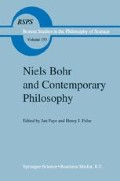Abstract
The day before his death Niels Bohr said, in an interview with Thomas Kuhn:
There are all kinds of people, but I think it would be reasonable to say that no man who is a philosopher really understands what one means by the complementary description ... they did not see that it was an objective description, and that it was the only possible objective description. (Bohr, AHQP, interview 5, p. 3)
Access this chapter
Tax calculation will be finalised at checkout
Purchases are for personal use only
Preview
Unable to display preview. Download preview PDF.
Notes
See Schwartz (1977) for a general survey of and an anthology of the articles basic to this trend.
This has a strong parallel to the argument Strawson developed in (1959) from the conditions of the possibility of unambiguous reference to absent particulars to a descriptive metaphysics. This parallel is developed in MacKinnon (1982), 360–363.
These developments are treated in more detail in MacKinnon (1982) Chap. 5; in Jammer (1966), Chap. 3; in Mehra and Rechenberg (1982+) Vol. I, Chaps. 2 and 3; and in Pais (1990), Chap. 10.
Part I of Works 5 includes this paper and extensive background material.
See his letters printed in Works 5: to Heisenberg of April 18, 1925, 361; to Geiger of April 21, 79; to Fowler of April 21, 81; the July 25 Addendum to his article“On the Behavior of Atoms in Collision“, 204–06, where this is mentioned five times; and in his August, 1925, address,“Atomic Theory and Mechanics“ in ATDN, 25–51.
This hermeneutic principle is developed in Maimonides Guide, Part I, Chap. xxxiii, and in Aquinas’s Summa Theologiae I, q 68, a. 2.
The Bohr and Rosenfeld paper (1933) is translated in Cohen and Stachel, (1979), 357–412, and in Wheeler and Zurek (1983), Sec. IV. A detailed analysis of these papers is given in Darrigol (1991). During the 1930’s the research physicists at Bohr’s Institute joked that Bohr only relied on three mathematical symbols: `»’ (`much greater than’); `«’ (`much less than’); and (`about the same as’). See von Weizsäcker in French and Kennedy (1985), 186.
See his“Autobiographical Notes“, in Schilpp (1949), 32. The thermodynamic style of Einstein’s reasoning is treated in Klein (1967), and in Pais (1979).
This is cited by Seelig (1959), 256. Einstein expressed the view that physics aims at universal deductive systems whose axioms are originally based on sympathetic intuition throughout his career. Three of the clearest statements are in Einstein (1928), Einstein (1933), where intuition is coupled to the search for mathematical simplicity; and in Einstein (1936), which stresses the role of basic created concepts in science’s deductive unification while claiming that nothing can be said about how these concepts are obtained.
The role of monism in grounding Einstein’s synthesis of realism and unified field theory is analyzed in De Ritis and Guccione (1984). Einstein’s epistemological justification of this realism is analyzed in MacKinnon (1982), 376–390.
These debates were summarized in MacKinnon (1979); and anthologized in Leplin (1984); and in Churchland and Hooker (1985).
A history of this development may be found in the introductory sections of Suppe (1989).
Though Bohr came to make ‘phenomenon’ a technical term in his philosophy, his usage of this term was in the tradition of physics, a tradition well described in Bogen and Woodward (1988).
The pertinent material in Works 9. This is discussed in Bromberg (1972), (1976); MacKinnon (1982), 286–97; French and Kennedy, (1985), sect. IV; and Pais (1991), chap. 15.
In the conclusion of his contribution to the Einstein volume Bohr mentions Copenhagen discussions of two kinds of truths.“To the one kind belong statements so simple and clear that the opposite assertion obviously could not be defended. The other kind, the so-called ‘deep truths’, are statements in which the opposite also contains deep truth. Now, the development in a new field will usually pass through stages in which chaos gradually becomes replaced by order; but it is not least in the intermediate stage where deep truth prevails that the work is really exciting and inspires the imagination to search for a firmer hold.
Here I am slurring over the differences between the assertive-redundancy analysis of ‘true’, introduced by Ramsey and developed by Strawson (See Pitcher, 1964); Horwich’s minimalist theory (Horwich, 1990); and various pragmatic accounts.
Author information
Authors and Affiliations
Editor information
Editors and Affiliations
Rights and permissions
Copyright information
© 1994 Springer Science+Business Media Dordrecht
About this chapter
Cite this chapter
Mackinnon, E. (1994). Bohr and the Realism Debates. In: Faye, J., Folse, H.J. (eds) Niels Bohr and Contemporary Philosophy. Boston Studies in the Philosophy of Science, vol 153. Springer, Dordrecht. https://doi.org/10.1007/978-94-015-8106-6_13
Download citation
DOI: https://doi.org/10.1007/978-94-015-8106-6_13
Publisher Name: Springer, Dordrecht
Print ISBN: 978-90-481-4299-6
Online ISBN: 978-94-015-8106-6
eBook Packages: Springer Book Archive

